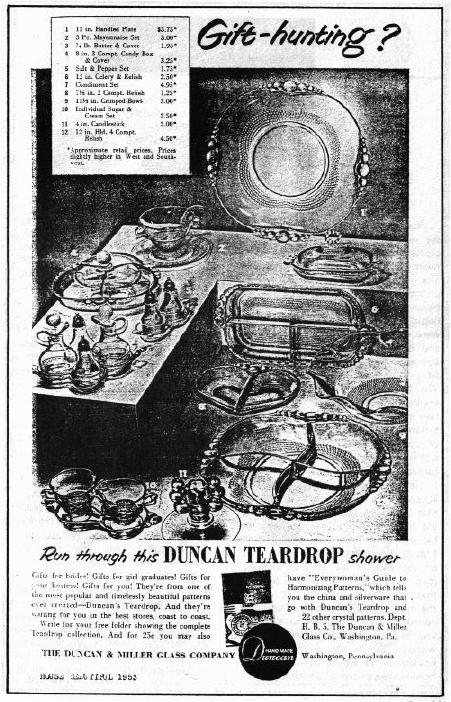National Depression Glass Association
Preserving America's Glass Manufacturing Heritage
Duncan & Miller's Teardrop
by Virginia Scott
Rainbow Review Glass Journal - June 1974
In the historically-rich country along the old National Turnpike in Washington County, Pennsylvania, reads a statement from a 1947 Duncan & Miller advertisement: "Duncan has been making lovely glassware like this Teardrop pattern for 80 years." Duncan, as the company was most often called, had a fine line of hand made glass which compares very favorably in brilliance, clarity and design with the glass of the other leading American companies.
"Duncan Teardrop" was named by Duncan & Miller as their most popular glassware pattern for the 1942 survey, "The 15 Most Popular Glassware Patterns." Many ads for "Teardrop" can be found in the popular magazines from 1937 to 1953.
"Teardrop," according to Duncan ads, was "a modern form of famous old hobnail glass." One ad described the pattern as "One of the most modern glass patterns, yet the tear-drops are so reminiscent of the old Early American hobnail glass that decorators suggest it for use in Colonial settings. It has the fine, honest simplicity of design its ancestor had."
"Teardrop," which was made in an extensive line of pieces and shapes, has, one ad explained: "tear-drops, like tiny jewels, set in wide expanses of flawless crystal." The 1953 ad shown here features some of the unusual serving pieces. This ad clearly shows many of the variations in shape that were used. Some pieces - plates, cups, saucers and some bowls -- have a round base (No. 9). Other pieces have a 4 sided scalloped base and 4 scallops around the edge (No. 1 & No. 12). Still others are heart-shaped (No. 8), rectangular (No. 6) oval (not shown) or are kidney-shaped (No. 5 & No. 10 trays).
Notice that four different handles are shown on the pieces in the ad: a large, flattened circle of glass fitted into a scallop, with graduated droplets on each side (No. 1); one flattened circle (No. 2, also used on oval console bowl and cream soups), graduated droplet, curving around a corner (No. 6) and a Large flattened circle with a smaller circle on each side (No. 10 - used on trays and round plates and bowls). Notice also that three different finials are shown (No. 3, No. 4 & No. 7). A 2-branched candleholder has graduated droplets flowing down the arms and a ball of crystal was in the middle over the cupped base.
The late Duncan patterns were mostly quite simple, depending for appeal on the beauty of the crystal itself and the shape of the base which was often repeated as scallop, around tho edge of the piece. (Examples "Canterbury," "Murano," "Viking.") When ornamentation was used, it was, perhaps, a band of geometric shapes between broad bands of clear crystal ("Teardrop" & "Duncan Diamond") or flowing lines molded into the glass ("Avalon" & "Symphony). The unusual, but beautifully shaped, handles and finials added an elegant touch.
Duncan & Miller's advertising slogan was "The Loveliest Glassware in America." It is not difficult to understand why.
 |